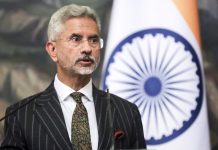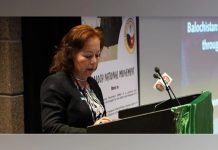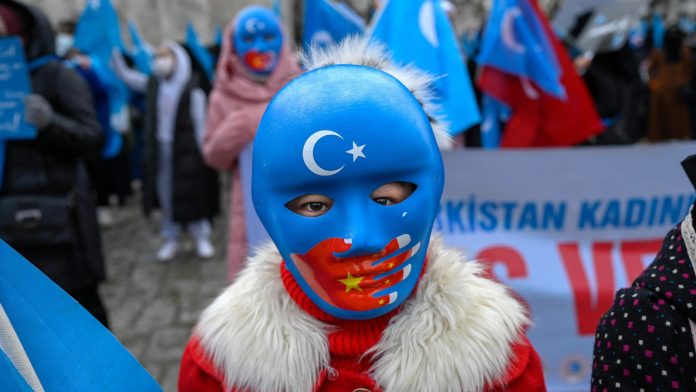Xi Jinping’s crackdown on the “disease” of separatism encouraged local Chinese officials to sweep up as many detainees as possible for internment camps in the Muslim-majority region of Xinjiang, where they faced what the U.S. has described as genocide.
Officials in the region, hoping to satisfy the Chinese president’s drive for draconian “reforms,” were incentivized to intensify the policy of repression, which escalated from “thought eradication” to mass internment, reeducation and sterilization under the guise of combating extremism, according to a new report.
The report, based on files obtained from Xinjiang Police Security Bureau and other local security sources, was released by China-sanctioned German anthropologist Adrian Zenz—a leading researcher on the topic whose past work shed light on the internment of an estimated 1 million or more Uyghurs and other Muslim minorities in Xinjiang Uyghur Autonomous Region since 2017.
The camps were part of the “medicine” prescribed by Xi for the “disease” of separatism. Detainees in the facilities, which Beijing has called “vocational education and training centers,” were subject to extreme neglect, torture, forced sterilization, and rape, according to the U.S., in what both President Joe Biden and former President Donald Trump’s administrations characterized as a “genocide.” A spokesperson for Chinese embassy in Washington told they were “schools” and compared them to Western anti-terrorism programs.
Zenz says the groundwork for the campaign to stamp out perceived extremism was in place even before year before Xi declared a “people’s war on terror” in 2014.
“The conceptual foundation for targeting wider populations for de-extremification had been laid; in 2014-16 officials trialed increasingly concentrated and centralized ‘thought eradication’ mechanisms; then in 2017 these were scaled into a mass internment campaign,” he writes.
The end result—overpopulated centers and the gradual transfer of “graduates” to either a closely supervised existence back home or to alleged forced labor in factories—was the product of a “centrally steered yet locally conducted policy experimentation process.”
The Escalation of Xinjiang Repression
By the early 2000s, Chinese government policy for dealing with the highly persecuted Falun Gong religious minority group—a combination of “formal imprisonment with extralegal reeducation”—set the stage for Xinjiang’s plan for de-extremifying elements in the Uyghur population believed to be extremist, Zenz writes.
In 2012, Zhang Chunxian, then the Chinese Communist Party Secretary of Xinjiang, wrote a policy document telling officials to “try out things first” and “vigorously innovate” in their campaign against “illegal religious activities” and “curbing the infiltration of religious extremist thoughts.”
Following a spate of deadly attacks in the restive region in 2013, Zhang declared a “people’s war on terror,” a phrase used by Xi the following year.
Xinjiang Justice Department party cadre Zhang Zhun told a visiting reporter with China’s Phoenix New Media that, in his experience, as much as 30 percent of the Muslim-majority population needed “education and guidance,” according to an October 2015 report.
Another 30 percent were deemed “polluted by religious extremist forces yet amenable to changes in ‘the general environment.'” A “very small number” had committed or were suspected capable of committing crimes and “must be resolutely defeated,” the official said.
Shortly before the mass internments began, Zhan’s replacement, newly appointed Party Secretary Chen Quanguo, held a “mobilization meeting” on carrying out Xi’s stated goals for the region.
An internal summary of Chen’s speech indicates he was setting his priorities in the coming crackdown on directives from the central government.
“Showing no mercy,” Xinjiang must carry out “dragnet-like blanketing investigations,” Chen said. Security forces must go “county-by-county, township-by-township, village-by-village,” leaving “no blind spots” in their effort to “eradicate all evils,” Chen said.
In 2017, a “great increase” in the volume of camp detainees followed “important instructions” from Xi himself, Zenz wrote, citing internal state documents from the Xinjiang Police files. He pointed out local officials expressed optimism in Xinjiang’s overall “relatively large” capacity to house inmates.
By the next year, however, local officials, in their efforts to be seen carrying Xi’s dictates, led to a glut in the camps’ populations.
In 2018, Chinese Minister of Public Security Zhao Kezhi noted that the “success” of the “strike hard” and “de-extremification” campaigns had led to “a great number of excess detentions [relative to capacity],” Zenz wrote.
Zenz compared this to local implementation of Xi’s “zero-COVID” policy during the pandemic, with city and provincial authorities under great pressure to enact stringent measures to avoid an outbreak happening on their watch.
“The incentive structure was over-enforcement,” Zenz told. In other words, it was better to detain too many and appear overzealous than detain too few and be blamed for a security incident.
Uyghur Testimony
In his report, Zenz also shared the testimony of a Uyghur man, speaking on condition of anonymity, who had been previously detained in a major camp in the south of Xinjiang as China began its drawdown of the centers and started transferring detainees elsewhere.
The man said that one day in 2019, he came across internal spreadsheets detailing the fate in store for every inmate in the facility. He said he had been granted temporary access to the room where this information was stored due to past training with computer systems.
According to the spreadsheets, about two-thirds of the detainees were slated for either continued imprisonment at a non-camp facility. Another approximate third were to be sent to “industrial parks” to work. The remaining few were to be allowed to return home under “near house-arrest conditions,” Zenz wrote.
The man, who later managed to leave China, said one camp security officer had described the process for transferring detainees this way: “The public security department, state security officers, and the judicial department are all looking at each ‘student’s’ file one by one. Those who should go home must go home, and those who should be sentenced must be sentenced … ‘schools’ like this one are everywhere in Xinjiang.”
China has denied such claims.
“There are no so-called ‘re-education camps’ in Xinjiang. The vocational education and training centers set up in Xinjiang in accordance with laws are schools,” Liu Pengyu, spokesperson for Chinese embassy in Washington, D.C., told.
He said the facilities were no different than rehabilitation efforts in the West, such as U.S. community correction initiatives, the U.K.’s Desistance and Disengagement Programme, and France’s “de-radicalization” centers.
“Extremism has been effectively contained” since the facilities were open, Liu said, adding that “public security has substantially improved with people’s happiness.”
































